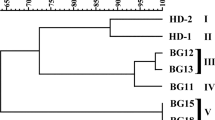Abstract
The chromosome of the Bacillus thuringiensis strain S184 that was toxic against the third instar larvae of Spodoptera litura with the LC50 of 9.74 μg/ml was successfully integrated into two genes of cyt1Aa and cry11Aa using the transposon Tn917, yielding the primary engineered strain TnX. The strain TnX was highly toxic to the third instar larvae of Culex pipiens fatigans with the LC50 of 5.12 ng/ml which was 1.82-fold higher than that of B. thuringiensis subsp. israelensis, but lowly toxic to lepidopterous larvae. By the protoplast fusion of the strain TnX and the strain S184-Tetr (resistance to tetracycline), the target engineered strain TnY was obtained. Against the third instar larvae of S. litura, the strain TnY LC50 was of 4.68 μ g/ml and increased by 2.08-fold in comparison with the parent strain S184. Against the third instar larvae of C. pipiens fatigans, the strain TnY LC50 was of 103.20 ng/ml. The two target genes of cyt1Aa and cry11Aa integrated into the chromosome were extremely stable and had little possibility of a second transposition. It was unclear whether some factors existing in the parent strain, S184, contributed to the high toxicity of the strains TnX and TnY.
Similar content being viewed by others
Author information
Authors and Affiliations
Additional information
Received: 30 November 2000 / Accepted: 10 January 2001
Rights and permissions
About this article
Cite this article
Yu, J., Pang, Y., Tang, M. et al. Highly Toxic and Broad-Spectrum Insecticidal Bacillus thuringiensis Engineered by Using the Transposon Tn917 and Protoplast Fusion. Curr Microbiol 43, 112–119 (2001). https://doi.org/10.1007/s002840010271
Issue Date:
DOI: https://doi.org/10.1007/s002840010271




